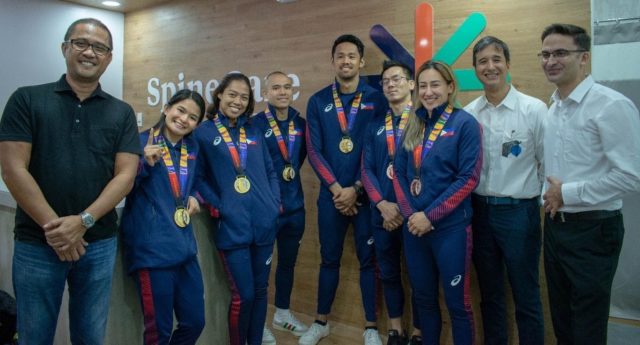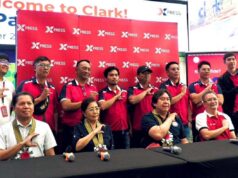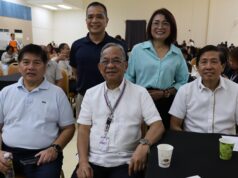Dr. Martin Camara, CEO of Clinics of Intercare and all-round sportsman is shown here with the Jiu Jitsu team at the 2019 SEAGames and is photographed after competing in the World Xterra in Maui, Hawaii last 2013.
With the gradual lifting of the community quarantine in some major cities and provinces in the Philippines where more activities are allowed, the recovery of sport tourism in the country is slowly moving forward into preparing for the revival of sports activities. Whether it’s competitive or non-competitive sports, the country is encouraged to proceed with safety protocols in mind despite the threat of Covid-19.
Addressing the tourism sector in the country in his fifth State of the Nation address on July 27, President of the Philippines Rodrigo Duterte mentioned that national and local government agencies must work hand in hand to bring back the country’s tourism glory through coordinated policies.
Duterte said in his speech, “In the same manner, the tourism and recreation industries, which are among the hardest hit by the pandemic, count on our full support. While we slowly try to put the fun back in our local travels, the national government agencies and local government units (LGUs) must harmonize their policies to boost tourism (while) ensuring everyone’s well-being. We enjoin our people to help boost the economy by traveling locally once the necessary systems are in place.”
With all things considered, professional sports in the country is finally granted permission to resume training on the condition that provisions of the GAB-PSC-DOH Joint Administrative Order (JAO) are followed. The JAO serves as a guideline on how to safely reboot the operations of professional sports in the country and states the allowable professional sports activities per risk severity level.
In high-risk areas (ECQ and MECQ), only non-contact sports or individual exercises shall be allowed. In moderate risk areas (GCQ and MGCQ with modifiers), championship and non-championship combat sports fights, such as boxing, MMA, Muay Thai scheduled abroad involving a GAB-licensed athlete may be permitted. Basketball and football may be allowed to resume training in GCQ areas, while a maximum of 10 players may be allowed to resume physical conditioning activities in MGCQ with modifiers areas. Boxing training is allowed in moderate areas provided that the fighters shall have no Covid-19 symptoms in the past 14 days and in low-risk areas (MGCQ without modifiers), practice and actual games may be permitted provided that the provisions of the JAO are strictly observed.
Following Duterte’s initiatives in reviving tourism and recreation in the Philippines and with the JAO signed, sports institutions and local organizers are proceeding to make headway in attracting the recovery of sports tourism in the country.
Chairman of Philippine Sports Tourism Awards (PSTA) Charles Lim shared in a statement that the PSTA alliance will focus on non-contact adventure sports involving individuals and small groups enjoying golf, biking, sailing, tennis badminton, squash and similar sports. This is based on the thrust of the Department of Tourism (DOT) to begin with domestic tourism in the country.
Lim further mentioned that the activities will have to be approved by the Inter Agency Task Force (IATF) in full compliance with the DOT in tours as well as resort and hotel operations. He urged the various national sports associations to seek approval for a JOA.
Taking the lead in the game, Ironman has activated its five principles on the return to responsible racing. The following guidelines are expected: regular disinfection and wearing of standard personal protective equipment; rigid scanning and testing days prior to event; overall decrease in participants; touchpoint minimization; and education of athletes to self-reliance.
General manager of Sunrise Events of the Ironman Group Princess Galura expressed, “From the standpoint of local organizers and local government units, it’s best to work with a big organization and brand like Ironman to jumpstart the economy. It will give confidence to participants and constituents as Ironman will also ensure that we do everything to ensure safety.”
The iconic Ironman triathlon is a mainstay annual event in Cebu, Subic and Davao.
As discussions and preparations to resume sports events in the Philippines are underway, the center of attention is shifted to the nation’s athletes. The off-season has been running for far too long and it’s hight time athletes start gearing up for the new normal.
Maintaining fitness during an off-season can be quite an overwhelming job for athletes as keeping their competitive levels high require a lot of effort and attention. To help out athletes in their preparation, Chief executive officer and director of Clinics of Intercare Dr. Martin Camara, shares his favorite tips on keeping the body in shape in an off-season.
Dr. Camara is known as an active member of the sports community. One of his many notable involvements was when he sat as co-chair in medical commission with the Philippine Olympic Committee from 2005 to 2018. He is also a triathlete himself who participated in a number of marathons and competitions. The 2013 Xterra World Championship, the 2013 IronMan 5150 Century Tuna, the TCS New York City Marathon and the 2012 Xterra Philippines were just a few of them.
According to Dr. Camara, the ancestral approach to training is based on the theory that the human body is naturally designed to perform low-level physical activities to a great extent with occasional bursts of extremely high intensity activities, which build endurance without significant physical and metabolic damage.
For athletes seeking to maintain fitness, this approach requires preservation of muscle endurance and aerobic capacity with activities like running, treadmill, indoor or outdoor cycling, rowing, kettlebell swings, squats, jumping jacks, mountain climbers and squat thrust; the maintenance of ideal ratios of strength and muscle mass through a seven-minute program designed by the ACSM Health and Fitness Journal and a super slow workout for muscle endurance; an increase in mitochondria density with all-out sprints; the continuance of stamina or endurance work through running, hiking, and other similar exercises.
Based on the work of Ben Greenfield—one of the most influential personalities in health and fitness in the United States and author of the books “Beyond Endurance” and “Boundless”, these workouts simply put the basic principles of strength and conditioning to practice. To support this approach, Dr. Camara added, “The point of the exercise is to stress one’s cardiovascular and muscular system and cause adaptations to those tissues for them to become stronger and more resilient. Too much and one will injure. Too little and no adaptation or changes occur, leading to a plateauing of one’s fitness or race performance.”
This changeover within the sports tourism industry is a chance to promote great sports and recreation activities in different host cities throughout the Philippines. Moreover, this also sheds light to Selrahco’s Sports Tourism Forum (STF) where it creates awareness of the benefits of sports tourism across all regions. In fact, STF was instrumental in promoting Cebu, Clark, and Subic as sports hub since 2004 for this program is committed to establishing a particular city or province in the Philippines as an ideal sports venue.
In this case, PSTA prompts local government units, tour operators, resorts and hotels and event organizers to coordinate closely in order to elevate sports tourism in the country no matter how small the scale is.





